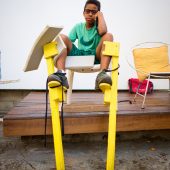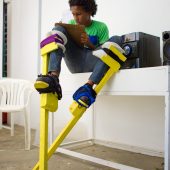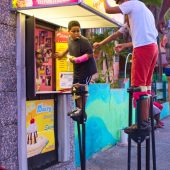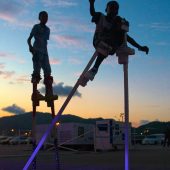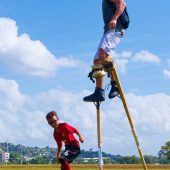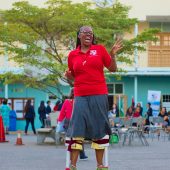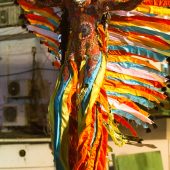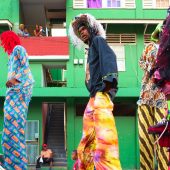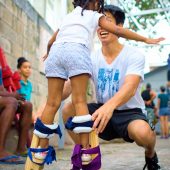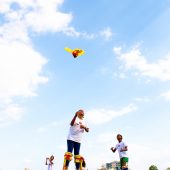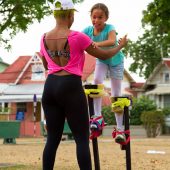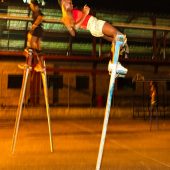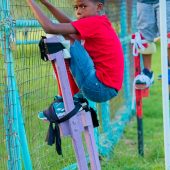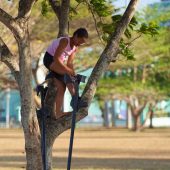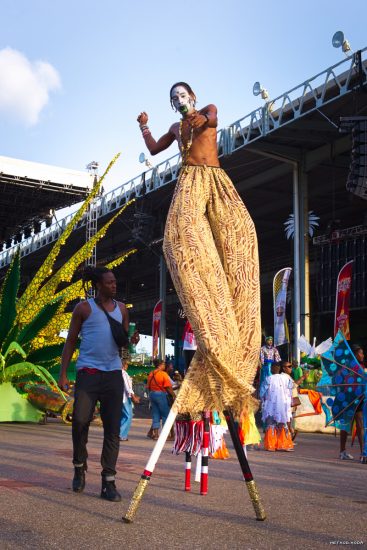
A row of stick-walks at a rugby goalpost on the Queen’s Park Savannah.
6th January, 2019.
(Shaun Rambaran / Sticks in de Yard)
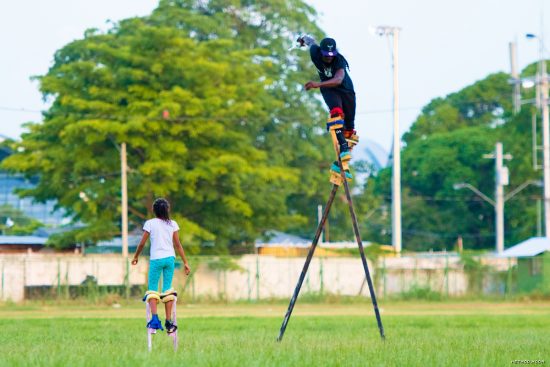
A young, beginning stickwalker observes Adrian ‘Daddy Jumbie’ Young.
Queen’s Park Savannah—Sunday 25th August, 2019.
(Shaun Rambaran / Sticks in de Yard)
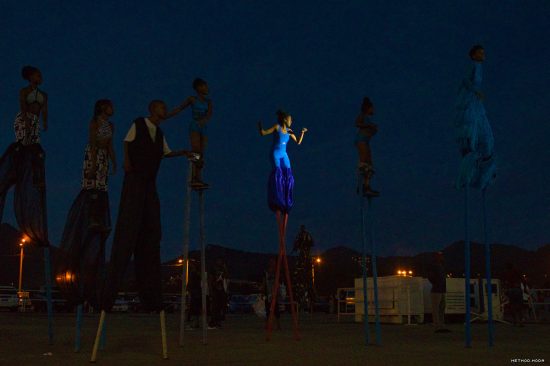
Lightspill from the nearby Grand Stand snipes out a single moko jumbie from the shadows at the Launch of Trinidad and Tobago Carnival 2019.
Queen’s Park Savannah—23rd September, 2018.
(Shaun Rambaran / Sticks in de Yard)
The Moko Jumbies of Trinbago is by Shaun Rambaran (portfolio: forge.co.tt | blog: method.moda):
Our History
Welcome to Trinbago (officially, Trinidad and Tobago), the twin-island nation found at the southernmost end of the Caribbean. We are a colourful callaloo of communities and cultures, proud of our heritage and always loving a good time. Our yearly Carnival is arguably one of the most diverse and photogenic street festivals of the World and it’s a great place to bring along your Nikon kit. Pretty people in feathers and beads, fire-breathing devils, steelbands, and cracking whips all glitter the landscape. And there—towering, commanding respect among the cacophony—are the moko jumbies. To give some context, please allow me a quick, condensed history:
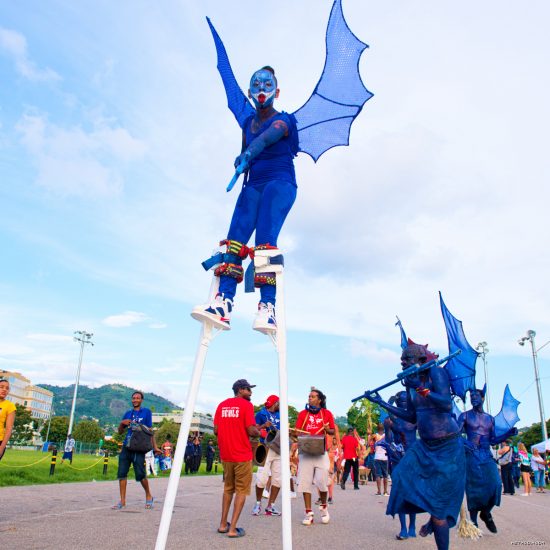
Jada crosses genre, becoming a blue devil with Next Level Devils, while atop her usual moko jumbie sticks.
Queen’s Park Savannah—29th September, 2019.
(Shaun Rambaran / Sticks in de Yard)
As with the rest of the West Indies, our dense past saw us grind through the dim chapters of the Atlantic Slave Trade, changing hands as a colonial state multiple times. On Trinidad, the Taíno and other first peoples [1] eventually fell to the Spanish (1510-1595) who would later bring French plantation owners onto the island from 1783. Tobago, meanwhile, underwent colonisation attempts by the Dutch, British, French, and Courlanders. Between 1793 to 1797, the British came to control both islands and installed enslaved persons purchased from a few West African countries, including such ethnic groups as the Akan, Igbo, Kongo, Makua, Yoruba, and various Gbe-speaking peoples [2]. August 1834 saw the end of slavery in the Caribbean as market forces triggered by the industrial revolution, combined with social pressures by abolitionist movements in Britain, made slavery no longer financially profitable nor politically desirable [3]. To fill the labour shortfall, an attempt to indenture ex-slaves was tried and failed. Between 1845 to 1917, Indian indentures were seduced to Trinidad. So too, Chinese indentures were coaxed between 1848 to 1852 [4]. A half-century later, the religious persecution of Arab Catholics from the region once known as Greater Syria lead to some of those groups escaping into Trinbago [5]. 1937 noted the beginnings of Trinbagonian nationalism, and decades of demonstrations and riots would eventually, after a series of steps, see Trinbago finally become independent in 1963.
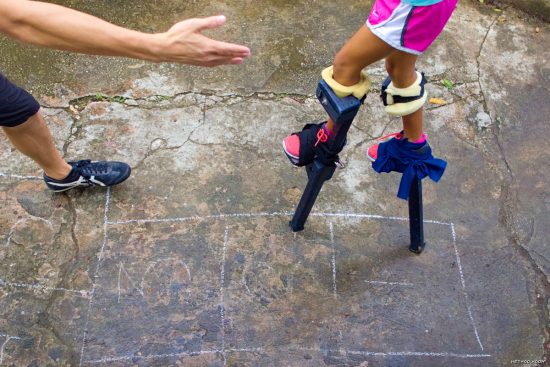
Using hopscotch squares as an innovated practice pitch for stickwalking.
Alice Yard—7th January, 2018.
(Shaun Rambaran / Sticks in de Yard)
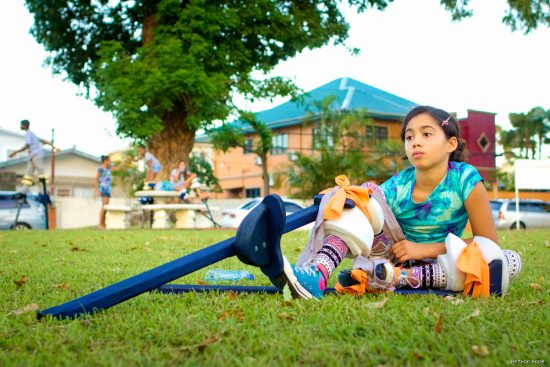
A young stickwalker sits in the Augustus Williams Park grass while undoing her stilts.
Woodbrook—7th January, 2018.
(Shaun Rambaran / Sticks in de Yard)
“Many rivers flowed into this sacred isle,” as poetically summarised by Trinbagonian Calypsonian, David Rudder [6]. While much of the world today seems to argue over what it means to be ‘multi- cultural’, Trinbago’s unique blend of diverse heritages thrown together by history—generations who have jointly grown and overcome challenges on this land—has seen us long surpass that mark, becoming instead ‘inter-cultural’. We are a remarkable place where average people from every ethnic background can be seen actively partaking in the expressions of the others. The emblems of each of those cultures remain; Worn on the varied faces and beautiful skin colours of our people; they are felt in our eclectic ranges of rhythms and music; beheld in our dances; tasted in our foods; seen in our traditions. Among these traditions stands tall the ‘moko jumbie’.
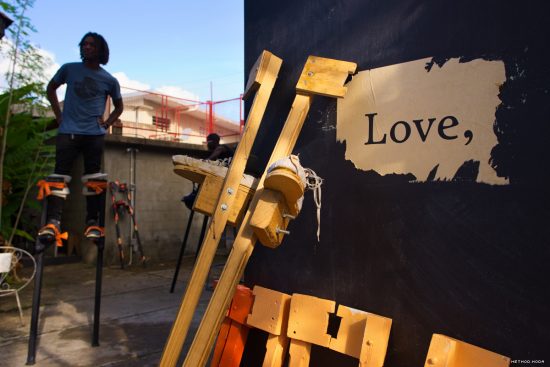
Sticks lean beside a four-letter word, left on the wall from a past Art performance. The silhouette of ‘Charlo’ Alfonso can be seen in the background.
Alice Yard—14th January, 2018.
(Shaun Rambaran / Sticks in de Yard)
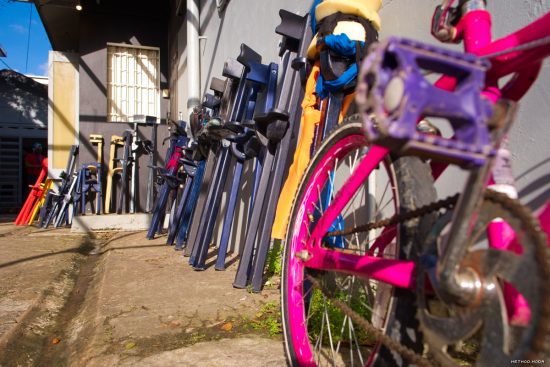
A repeatedly cited goal of the #1000mokos initiative: Fostering a similar feeling toward walking on sticks as customarily is felt toward skateboarding or riding bikes.
Alice Yard—14th January, 2018.
(Shaun Rambaran / Sticks in de Yard)
‘Jumbie’ (or ‘zombie’ in Haiti) is a Caribbean word meaning ‘spirit’ [8]. ‘Moko’, a West African guardian deity, uses his great height to spy danger at a distance and to protect his village. Enslaved persons enduring the Middle Passage thought of Moko using his height to walk along the seabed [7] following the slaver ships, so to protect his people during their suffering and into their unknown, new lands. The tradition of walking on stilts (sticks), which exists in a handful of islands across the Caribbean, serves as a reminder of that guardian spirit. Those stick-walkers who—via their great height, great skill, and awe-inspiring portrayals—most “embody the spirit of the stick” [9] are fit to be called ‘moko jumbies’. In Trinbago, moko jumbies are associated with Carnival.
Photographing de Yard
It was a chance encounter, a few Carnivals ago, with these moko jumbies which so fascinated my friend, Artist, Joshua Lue Chee Kong that he began a collaboration with Designer, Kriston Chen, to seek to learn. A challenging year ensued. The kind help and input of folks like Debbie Estwick, Michael Lee Poy, Sean Leonard, and Bruce Cayonne, eventually allowed the first ever stick-walking session at a collective art space called ‘Alice Yard’ to take place on 29th January, 2017. Josh extended the invitation to his friends to come give walking a try and I readily joined, my Nikon in hand. From that day to now, as at the time of writing, I’ve been a member of ‘Sticks in de Yard’ (as the group came to be known) [10], walking a couple times (although I’m not very good), helping new-comers to feel less terrified, and making lots of photographs along the way. The group, being located in the capitol of Trinidad and having a light, leisurely vibe [11], became very inviting to all mixes of colours, genders, and ages. This aspect of Sticks in de Yard I hope most to show with my coverage.
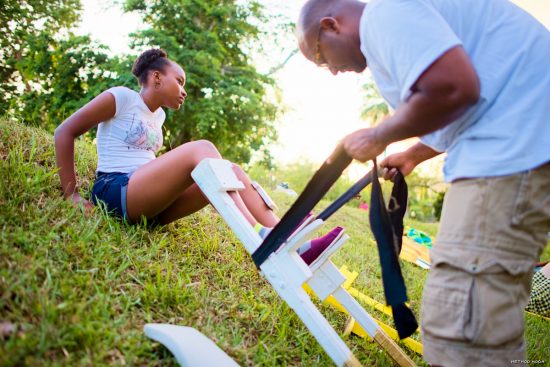
A first-time stiltwalker has her sticks tied by Damir Ali at Wildflower Park, Port of Spain.
Wildflower Park—1st April, 2018.
(Shaun Rambaran / Sticks in de Yard)
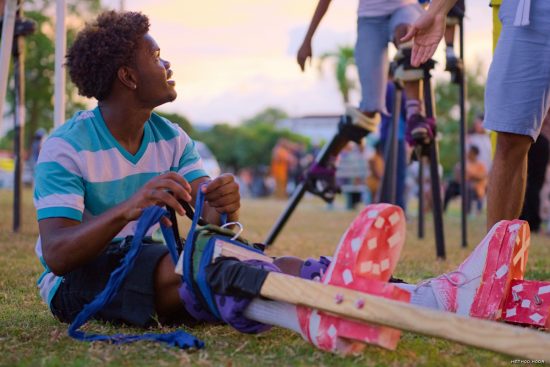
Wearing his signature striped shirt, Shervon Clarke, orients himself after a minor fall at Adam Smith Square.
Woodbrook—10th May, 2018.
(Shaun Rambaran / Sticks in de Yard)
For myself and my growth as a photographer, 2017 saw me pondering the notion of ‘the long project’. While great, individual photographs can become iconic, there’s a power that only surfaces through a slow, patient body of work. And so my fortweekly coverage of Sticks in de Yard has been done, making use of my Nikon gear which, depending on the day, can be any combination of:
- Nikon D750 camera body;
- Nikon D7500 camera body;
- Nikkor 28mm f1.8 prime;
Nikkor 24-70mm f2.8 zoom;
Nikkor 70-200mm f2.8 zoom;
Nikon SB700 speedlight.
I photograph raw, using an amazing piece of gratis, open-source software called ‘RawTherapee’ to do my conversion.
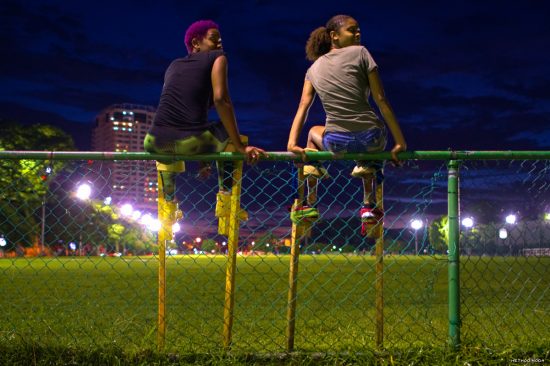
A cool dusk falls upon Nelson Mandela Park, Woodbrook. Mekhai and Rory sit on a fence, resting from a long walk.
Woodbrook—30th September, 2018.
(Shaun Rambaran / Sticks in de Yard)
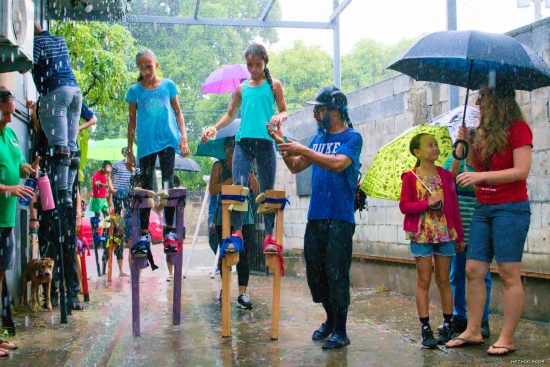
A ‘Sticks in de Yard’ session at Alice Yard and environs on a rainy Sunday.
Woodbrook—14th July, 2019.
(Shaun Rambaran / Sticks in de Yard)
As a photographer, I see my role primarily as storytelling (or rather, storyshowing). My goal is to offer viewers enough information in each individual frame (and then all of the frames together) so that they can, for themselves, get a rough sense of what the moment was like and what was taking place. A caption can fill in the details (the date, location, names of people, etc), however I aim for the single photograph itself to speak most of its own words. As said by Photojournalist, Dan Winters, “A photograph does not require any information beyond the confines of the frame.”
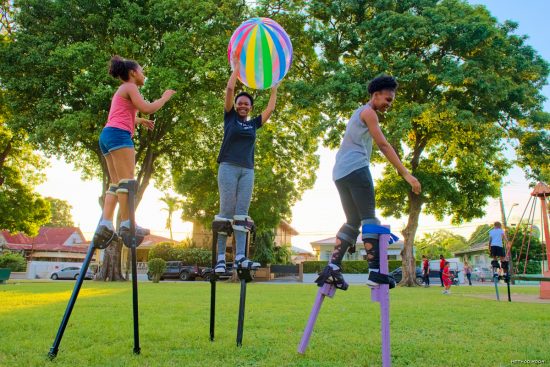
Outdoor play is a core value of Sticks in de Yard.
Augustus Williams Park, Woodbrook—8th September, 2019.
(Shaun Rambaran / Sticks in de Yard)
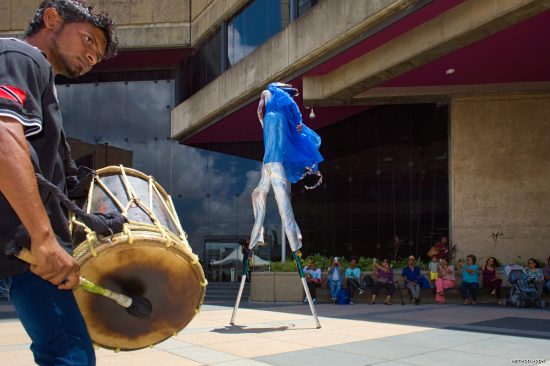
During International Museum Day 2019, tassa drummers provide an exciting rhythm to which the moko jumbies dance.
Courtyard, The Central Bank, Port of Spain—18th May, 2019.
(Shaun Rambaran / Sticks in de Yard)
Every artistic, technical, and journalistic tool comes into play:
To begin with, I try to not disturb the scene. Most times, I find there’s more storytelling value in candid, genuine moments, than those images which are posed. Details in the scene, say the random beer bottles or the old lady leaning out her window to spy, are all parts of the story. Nothing is ‘photoshopped’ out nor in. No ‘fake news’!
Expressions and body-language are telling. Is the first-time walker feeling fearful? Maybe proud? Comfortable? Maybe slightly embarrassed? Is the walker dancing and having fun? This crucial information adds layers of complexity and interest into a photograph when it can be caught. The work of Paul Ekman and others in the many fields of non-verbal communication continues to aid and inform my photography today. I earnestly suggest any photographer reading this to go out and learn how to accurately read facial expressions and body language. It may be an irreplaceable ‘soft skill’ for a tog!
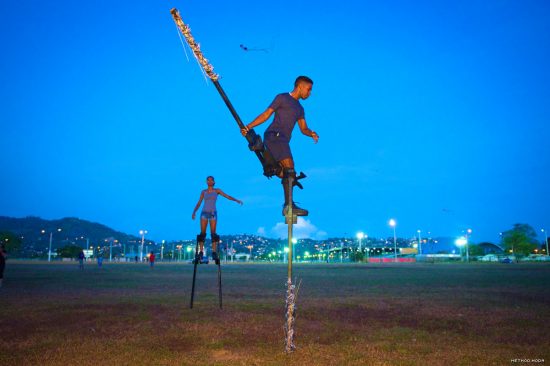
A few weeks before Easter in Trinbago, stickwalkers gather at Queen’s Park Savannah to fly kites while practicing their walking.
As Sun sets, Jamal Arneaud (centre), Rory Johnson (distance), and Mekhai Weekes (off-camera), begin performing stickwalking tricks in the twilight.
Queen’s Park Savannah—7th April, 2019.
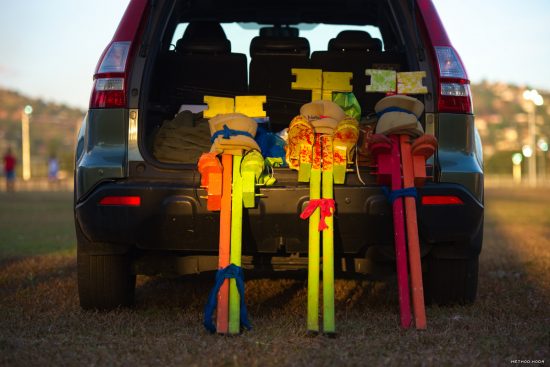
Dappled sunlight picks out a few, colourful sticks awaiting their owners.
Queen’s Park Savannah—7th April, 2019.
(Shaun Rambaran / Sticks in de Yard)
Line direction carries meaning; This was one of the first lessons of Desmond ‘Sir’ Clarke, one of my first photography mentors [12]. Horizontals tend to suggest calmness and stability; Verticals suggest height and pride; Diagonals suggest movement and dynamism. Diagonal lines tend also to attract viewers’ attention more than the others. Therefore I work to keep my backgrounds as serene as possible by using horizontals and verticals there as much as the situation permits. This allows the dynamic, irregular shapes of human bodies—the walkers—to play against that calmness, and so stand out from it. The exception comes in those rare situations of a walker falling, when there’s an accident, or someone feeling ill; I’ve found that diagonals in those situations help to communicate the subjects’ feelings of panic or unease. You’ll find this technique used in the work of old thriller / suspense movie directors; the likes of Hitchcock et al.
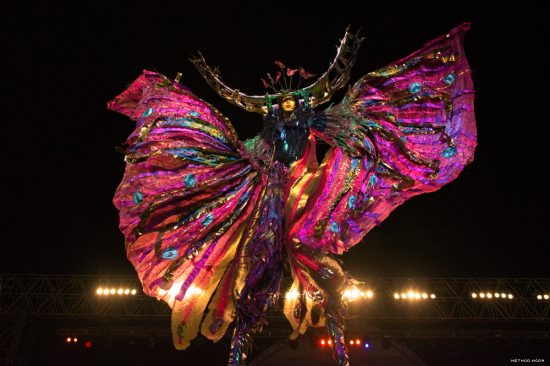
TT Carnival 2019 Senior Kings Preliminaries: ‘The Peacock becomes the Windows of the Universe’ as portrayed by Tekel ‘Salti’ Sylvan of the moko jumbie band, Moko Somõkõw, designed by Alan Vaughan.
Grand Stand, Queen’s Park Savannah—21st February, 2019.
(Shaun Rambaran / Moko Somõkõw)
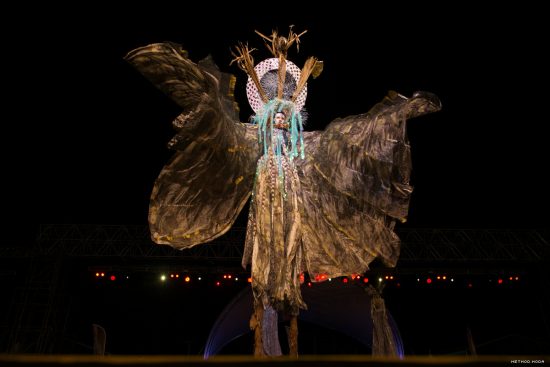
TT Carnival 2019 Senior Queens Preliminaries: ‘Mariella, Shadow of Consciousness’ as portrayed by Shynel Brizan of the moko jumbie band, Moko Somõkõw, designed by Alan Vaughan.
Grand Stand, Queen’s Park Savannah—21st February, 2019.
(Shaun Rambaran / Moko Somõkõw)
The walkers are tall. Staying close on a wide angle, especially with the D750’s FX, tends to keep them looking as tall and impressive as they are. With stick-walkers, so high in the sky they are, that heroic angles occur naturally. That said, on wide, one challenge I’ve continued to face and haven’t yet solved is how to deal with the bright sky creeping into the photograph. It’s less of an issue on a bright, sunny day —ironically enough—because I found moving myself into a front- or sidelit position allows the bright sunlight striking the subjects to match the brightness of the sky, roughly equalising their exposures. On Nikon’s wide dynamic range, the sky retains its beautiful blue colour in these sorts of scenarios. What I’ve not yet been able to adequately figure is how to handle an overcast day. With the Light not bright enough to match the ground’s exposure to the sky, there seems to be no recourse but letting the sky blowout to white (or else keep the sky out of frame entirely by switching to tele’). Flash is definitely an option and I need to practice using my SB700 more often in the future!
Have you ever tried your camera’s ‘Store Focal Point by Orientation’ feature? It allows the user to quickly change format (between portrait and landscape orientations) without having to scramble the d- pad, moving focal points. When working candidly on massive, fast-moving subjects such as stickwalkers, I’ve found there’s no replacing this feature for quickening one’s response time. Combined with AF-C set to back-button autofocus, I’m able to react quickly to a photogenic change in situation, getting my pictures off before anyone knows what’s happened.
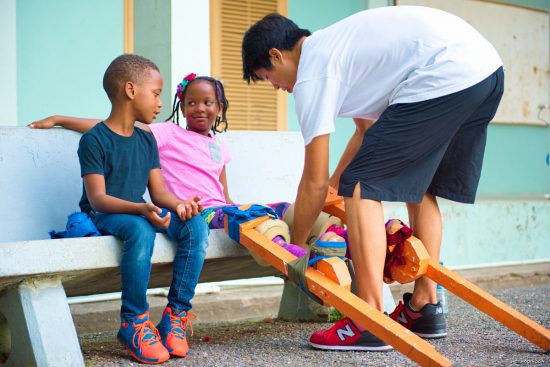
The ‘Sticks in de Yard’ group is invited by Holy Name Convent, Port of Spain to host a stiltwalking session there as part of ‘Holy Name Convent Connections’.
Co-created by past pupils, Ayesha Cowie-Ayong and Charlene Clarke-Sadler, the event aims to encourage school stakeholders to adopt school development and maintenance projects.
12th January, 2019.
(Shaun Rambaran / Sticks in de Yard)
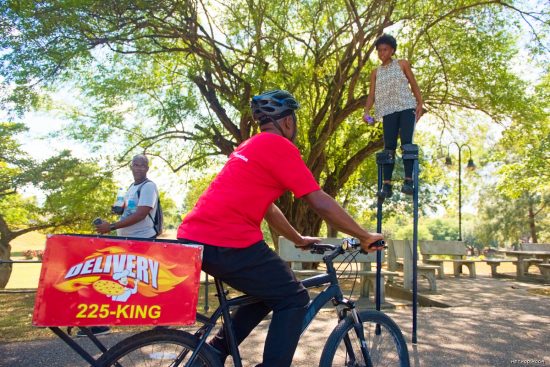
A Mario’s Pizza delivery man, cycling the path around the Queen’s Park Savannah, passes a training stickwalker during a ‘Yard Core’ fitness session.
Port of Spain—10th February, 2019.
(Shaun Rambaran / Sticks in de Yard)
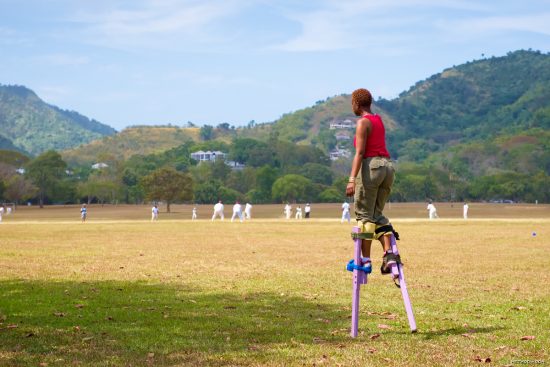
On a hot, Sunday afternoon, a practicing stickwalker cuts through the Queen’s Park Savannah, walking by a cricket game in progress.
Queen’s Park Savannah, Port of Spain—17th February, 2019.
(Shaun Rambaran / Sticks in de Yard)
Lastly, perhaps the most important tool: “It’s always worth it to keep pushing until you’re happy,” as said by Alex Smailes, former Photojournalist, and another person I was so lucky to meet. It’s only rarely that the immediate scene which presents itself before me will be ideal. Most times, I find I must keep circling around, spiralling closer, seeing the Light from different angles, ‘working’ the scene until I gradually begin to make better and better images of the day. Nothing replaces determination and persistence.
Evolution
In the enduring words of Calypsonian, Christopher ‘Tambu’ Herbert, “A nation without a culture is a people without a soul.” [13]
We’re so lucky as photographers that we often get called to witness and document culture and history as they manifest. One day future historians might well be picking over the work which we’ve been blessed to make today, piecing together what was the story of our time. This isn’t a responsibility to ignore. Our work is more than social media content.
And what will be the future story of stick-walking? Will the tradition carry on? In Trinbago, Sticks in de Yard is only one of a handful of stick-walking groups. The ongoing efforts of Glenn ‘Dragon’ DeSouza and his Keylemanjahro group from 1985 onward; Junior Bisnath’s Kaisokah from the mid- 90s; Adrian Young’s Tarodale Jumbies and Future Jumbies (2018) among others are sources of encouragement. Every child taught in the tradition is a possibility for the future.
Trinbago Carnival is the week before Ash Wednesday every year. If you get here early enough, seek us out at Sticks in de Yard and we’ll be more than happy to put you up!
Be sure to walk with your camera.
- Ennui sits and waits patiently to be strapped onto his sticks. Alice Yard—18th March, 2018. (Shaun Rambaran / Sticks in de Yard)
- A young moko sits inside, writing, while still wearing his stilts. Alice Yard—18th March, 2018. (Shaun Rambaran / Sticks in de Yard)
- Stiltwalkers casually buy homemade icecream and lollies from J&M Dairy Delights. Ariapita Avenue—2nd September, 2018. (Shaun Rambaran / Sticks in de Yard)
- As night comes over The Launch of Trinidad and Tobago Carnival 2019, stilt-walkers from assorted moko jumbie groups dance in the dusk. Groups which were present, listed in alphabetical order, included Sticks in de Yard (Woodbrook), Future Jumbies (San Fernando), Kaisokah (San Fernando), and Kilimanjaro (Cocorite). Queen’s Park Savannah—23rd September, 2018. (Shaun Rambaran / Sticks in de Yard)
- A young footballer beats his way past a very tall opponent. Queen’s Park Savannah—6th January, 2019. (Shaun Rambaran / Sticks in de Yard)
- Sister Renée Hall of Holy Name Convent relishes her very first experience walking on sticks. The ‘Sticks in de Yard’ group was invited to host a stiltwalking session at the secondary school as part of ‘Holy Name Convent Connections’. 12th January, 2019. (Shaun Rambaran / Sticks in de Yard)
- Russell ‘Rusty’ Grant of Moko Somõkõw performs at the Traditional Individuals Competition on Adam Smith Square, Woodbrook. 26th February, 2019. (Shaun Rambaran / Moko Somõkõw)
- Leaving Canboulay, a group of moko jumbies walk past a tall, Prince Street building. Spectators watch from every height. Port of Spain—1st March, 2019. (Shaun Rambaran)
- A young boy chooses which pair of sticks he wishes to walk. Queen’s Park Savannah—7th April, 2019. (Shaun Rambaran / Sticks in de Yard)
- Kriston ‘Fearless Leader’ Chen of Sticks in de Yard (formerly ‘1000mokos’) encourages a young moko jumbie-in-training to take steps in her tiny stilts. Alice Yard, Woodbrook—7th January, 2018. (Shaun Rambaran / Sticks in de Yard)
- A few weeks before Easter, a handful of young, practicing stickwalkers fly kites at the Queen’s Park Savannah. In Trinbago, flying kites on Easter Sunday is an ongoing pasttime and spectacle. Port of Spain—24th March, 2019. (Shaun Rambaran / Sticks in de Yard)
- Mekhai Weekes aids an expressive young stickwalker as she attempts to step from a paved walkway onto the grass of Augustus Williams Park. Woodbrook—5th May, 2019. (Shaun Rambaran / Sticks in de Yard)
- A very skillful, Keylemanjahro stickwalker performs a lean during a training session at Valleyharps Panyard. Petit Valley—8th June, 2019. (Shaun Rambaran / Sticks in de Yard)
- Co-inciding with the final day of Carifesta XIV, a ‘Sticks in de Yard’ session is held at the Queen’s Park Savannah on Sunday 25th August, 2019. (Shaun Rambaran / Sticks in de Yard)
- Climbing a tree for added height, Xica fastens her own sticks. Queen’s Park Savannah—7th April, 2019. (Shaun Rambaran / Sticks in de Yard)
Citations:
[1] https://method.moda/gazette/kairi
[2] https://en.wikipedia.org/wiki/Atlantic_slave_trade
[3] ‘Capitalism and Slavery’, Eric Williams (1941)
[4] ‘Trinidad and Tobago, Terrific and Tranquil’ by Hansib Publications Limited (1994)
[5] https://www.nalis.gov.tt/Resources/Subject-Guide/Syrian-Lebanese
[6] ‘The Ganges and the Nile’ by David Rudder (1999) (http://www.islandlyrics.com/lyrics- david_rudder-the_ganges_and_the_nile_1999.htm)
[7] http://www.traditionalmas.com/project/moko-jumbie/
[8] https://exemplore.com/paranormal/Jumbies-of-Guyana
[9] Direct quote of Moko Somõkõw Designer, Alan Vaughan (2018) [10] https://www.facebook.com/SticksInDeYard/
[11] ‘Deconstructing 1000mokos’ by Akilah Edwards-Rose
[12] Another of Mr. Clarke’s lessons was, “Only the lead mule sees a change of scenery. All the rest see ass.”
[13] ‘Culture’ by Christopher ‘Tambu’ Herbert (1988) (https://www.youtube.com/watch? v=yGRP0n0TjX4)
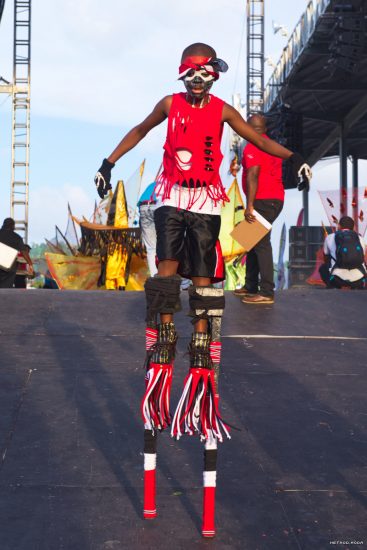
A young moko jumbie at the Launch of Trinidad and Tobago Carnival 2020 sports Trinbago’s national colours.
Queen’s Park Savannah—29th September, 2019.
(Shaun Rambaran / Sticks in de Yard)
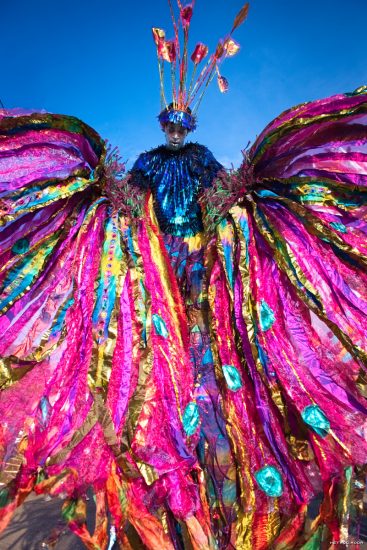
Moko Somõkõw’s King, Tekel ‘Salty’ Sylvan, wears a light version of his 2019 costume at the Launch of Trinidad and Tobago Carnival 2020.
Queen’s Park Savannah—29th September, 2019.
(Shaun Rambaran / Moko Somõkõw)
If you have an interesting idea for a guest post, you can contact me here.
